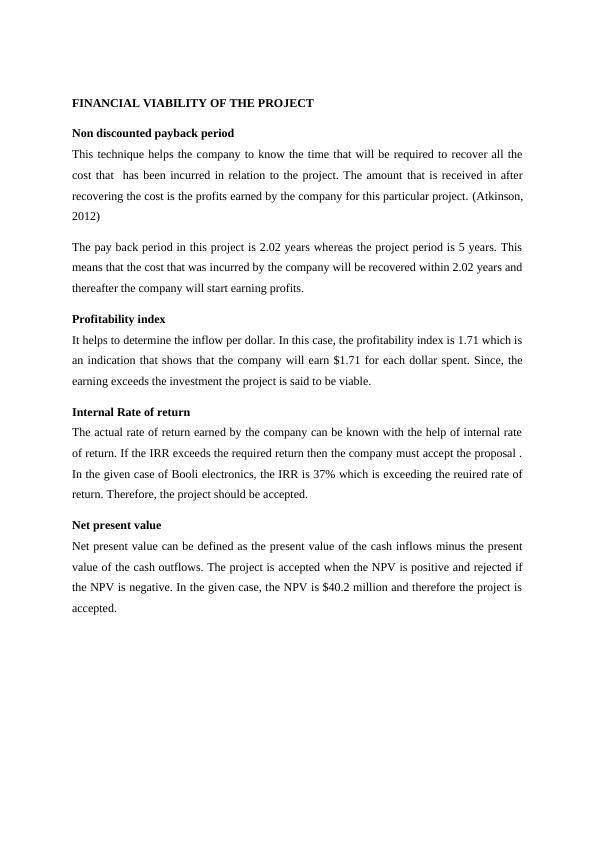Financial Viability of a New Project: Capital Budgeting Analysis
Added on 2023-06-12
25 Pages2866 Words486 Views
BUSINESS FINANCE

Contents
INTRODUCTION......................................................................................................................3
FINANCIAL VIABILITY OF THE PROJECT........................................................................4
Non discounted payback period.............................................................................................4
Profitability index...................................................................................................................4
Internal Rate of return............................................................................................................4
Net present value....................................................................................................................4
SENSITIVITY ANALYSIS.......................................................................................................5
Change in the sale price..........................................................................................................5
Changes in sales quantity.......................................................................................................5
EFFECT OF LOSS OF SALE OF OTHER MODELS DUE TO NEW PROJECT..................7
CONCLUSION AND RECOMMENDATION.........................................................................8
Bibliography...............................................................................................................................9
INTRODUCTION......................................................................................................................3
FINANCIAL VIABILITY OF THE PROJECT........................................................................4
Non discounted payback period.............................................................................................4
Profitability index...................................................................................................................4
Internal Rate of return............................................................................................................4
Net present value....................................................................................................................4
SENSITIVITY ANALYSIS.......................................................................................................5
Change in the sale price..........................................................................................................5
Changes in sales quantity.......................................................................................................5
EFFECT OF LOSS OF SALE OF OTHER MODELS DUE TO NEW PROJECT..................7
CONCLUSION AND RECOMMENDATION.........................................................................8
Bibliography...............................................................................................................................9

INTRODUCTION
Every time a company receives a proposal for a new project, it evaluates the financial
impacts of the opportunity. In order to evaluate the financial variability of a new project,
capital budgeting is used as a tool. There are certain rules in used in the application of this
tool of cost accounting. It is an important and a widely used tool that can be undertaken by
keeping in mind certain important points.
Every time a company receives a proposal for a new project, it evaluates the financial
impacts of the opportunity. In order to evaluate the financial variability of a new project,
capital budgeting is used as a tool. There are certain rules in used in the application of this
tool of cost accounting. It is an important and a widely used tool that can be undertaken by
keeping in mind certain important points.

FINANCIAL VIABILITY OF THE PROJECT
Non discounted payback period
This technique helps the company to know the time that will be required to recover all the
cost that has been incurred in relation to the project. The amount that is received in after
recovering the cost is the profits earned by the company for this particular project. (Atkinson,
2012)
The pay back period in this project is 2.02 years whereas the project period is 5 years. This
means that the cost that was incurred by the company will be recovered within 2.02 years and
thereafter the company will start earning profits.
Profitability index
It helps to determine the inflow per dollar. In this case, the profitability index is 1.71 which is
an indication that shows that the company will earn $1.71 for each dollar spent. Since, the
earning exceeds the investment the project is said to be viable.
Internal Rate of return
The actual rate of return earned by the company can be known with the help of internal rate
of return. If the IRR exceeds the required return then the company must accept the proposal .
In the given case of Booli electronics, the IRR is 37% which is exceeding the reuired rate of
return. Therefore, the project should be accepted.
Net present value
Net present value can be defined as the present value of the cash inflows minus the present
value of the cash outflows. The project is accepted when the NPV is positive and rejected if
the NPV is negative. In the given case, the NPV is $40.2 million and therefore the project is
accepted.
Non discounted payback period
This technique helps the company to know the time that will be required to recover all the
cost that has been incurred in relation to the project. The amount that is received in after
recovering the cost is the profits earned by the company for this particular project. (Atkinson,
2012)
The pay back period in this project is 2.02 years whereas the project period is 5 years. This
means that the cost that was incurred by the company will be recovered within 2.02 years and
thereafter the company will start earning profits.
Profitability index
It helps to determine the inflow per dollar. In this case, the profitability index is 1.71 which is
an indication that shows that the company will earn $1.71 for each dollar spent. Since, the
earning exceeds the investment the project is said to be viable.
Internal Rate of return
The actual rate of return earned by the company can be known with the help of internal rate
of return. If the IRR exceeds the required return then the company must accept the proposal .
In the given case of Booli electronics, the IRR is 37% which is exceeding the reuired rate of
return. Therefore, the project should be accepted.
Net present value
Net present value can be defined as the present value of the cash inflows minus the present
value of the cash outflows. The project is accepted when the NPV is positive and rejected if
the NPV is negative. In the given case, the NPV is $40.2 million and therefore the project is
accepted.

SENSITIVITY ANALYSIS
Sensitivity analysis is a tool that is included in the capital budgeting process. It helps to know
the sensitivity of the net present value in relation to the cost. It helps to analyse the impact of
one independent variable on any dependent variable. The effect of any change in the price as
well as quantity is expressed in this project. (Berry, 2009)
Change in the sale price
In the given case, the selling price was increased by 1% which resulted in the increase of
4.35% NPV. It was seen that the NPV was $40.2 million initially but after the increment in
the selling price the NPV increased to $41.9 million. Therefore, we can see that the change in
selling price has an effect on the NPV.
The following were the observation on analysing the given case:
When the selling price was increased by 1% , the IRR of the project increase by
2.67%.
The increase in the selling price by 1% resulted in the decrease of payback period by
1.75%. Initially, the pay-back period was 2.02 years but then it decreased to 1.99
years.
There was an increase in the profitability index by 1.77% when the selling price was
increased by 1%. There was a change in the profitability index from 1.71 to 1.74.
We can conclude that the change in the price of the product, the net present value is the most
sensitive to any changes.
Changes in sales quantity
A change in the quantity of sales by 1% resulted in an increase of NPV by 2.23%. As we
know, the NPV was $40.2 million initially but it increased to $41.1 million as an effect of the
change in the sales quantity. This indicated that a 1% change in the sales quantity will
increase the NPV by 2.23%.s
Let us now see the effects on other financial factors because of the change in quantity-
1 percent increase in the quantity of sales leads to an increment of IRR by 1.30%.
Initially, the IRR of the project was 37.47% but now it has increased to 36.99%.
Sensitivity analysis is a tool that is included in the capital budgeting process. It helps to know
the sensitivity of the net present value in relation to the cost. It helps to analyse the impact of
one independent variable on any dependent variable. The effect of any change in the price as
well as quantity is expressed in this project. (Berry, 2009)
Change in the sale price
In the given case, the selling price was increased by 1% which resulted in the increase of
4.35% NPV. It was seen that the NPV was $40.2 million initially but after the increment in
the selling price the NPV increased to $41.9 million. Therefore, we can see that the change in
selling price has an effect on the NPV.
The following were the observation on analysing the given case:
When the selling price was increased by 1% , the IRR of the project increase by
2.67%.
The increase in the selling price by 1% resulted in the decrease of payback period by
1.75%. Initially, the pay-back period was 2.02 years but then it decreased to 1.99
years.
There was an increase in the profitability index by 1.77% when the selling price was
increased by 1%. There was a change in the profitability index from 1.71 to 1.74.
We can conclude that the change in the price of the product, the net present value is the most
sensitive to any changes.
Changes in sales quantity
A change in the quantity of sales by 1% resulted in an increase of NPV by 2.23%. As we
know, the NPV was $40.2 million initially but it increased to $41.1 million as an effect of the
change in the sales quantity. This indicated that a 1% change in the sales quantity will
increase the NPV by 2.23%.s
Let us now see the effects on other financial factors because of the change in quantity-
1 percent increase in the quantity of sales leads to an increment of IRR by 1.30%.
Initially, the IRR of the project was 37.47% but now it has increased to 36.99%.

1 percent increase in the quantity of sales led to a decrease of pay-back period by
0.94%. Initially, the pay-back period was 2.02 years but after the change in sales it
decreased to 2 years.
1 percent change in quantity of sales led to an increase in the profitability index by
0.89%. Earlier the profitability index was 1.71 but now it is 1.73.
Therefore, we can say that the NPV is the most sensitive to the change in the quantity of
sales.
The decisions taken by capital budgeting is based on certain assumptions and estimates. In
order to forecast the cash flows many factors are taken into consideration. Such factors can be
financial or non financial. (Boyd, 2013) The economy and the circumstances are dynamic in
nature and therefore, there may be a change in the estimates also. However, sensitivity
analysis helps us to analyse the effects of such changes.
The rate of return that is used to compute the present value of the cash flows are also based
on many assumptions (Datar M. S., 2015). It is one of the most important thing in the process
of capital budgeting. All the economy and risk factor should be taken into consideration in
order to determine the discount rate. The assumptions made should not be unreal as it would
give wrong results which will have an adverse impact on the investors of the company. If the
assumptions are not made properly then the results derived from the process will be
unreliable. (Girard, 2014)
0.94%. Initially, the pay-back period was 2.02 years but after the change in sales it
decreased to 2 years.
1 percent change in quantity of sales led to an increase in the profitability index by
0.89%. Earlier the profitability index was 1.71 but now it is 1.73.
Therefore, we can say that the NPV is the most sensitive to the change in the quantity of
sales.
The decisions taken by capital budgeting is based on certain assumptions and estimates. In
order to forecast the cash flows many factors are taken into consideration. Such factors can be
financial or non financial. (Boyd, 2013) The economy and the circumstances are dynamic in
nature and therefore, there may be a change in the estimates also. However, sensitivity
analysis helps us to analyse the effects of such changes.
The rate of return that is used to compute the present value of the cash flows are also based
on many assumptions (Datar M. S., 2015). It is one of the most important thing in the process
of capital budgeting. All the economy and risk factor should be taken into consideration in
order to determine the discount rate. The assumptions made should not be unreal as it would
give wrong results which will have an adverse impact on the investors of the company. If the
assumptions are not made properly then the results derived from the process will be
unreliable. (Girard, 2014)

End of preview
Want to access all the pages? Upload your documents or become a member.
Related Documents
ACC211: Booli Enterprise Manufacturing of Electronic Goods PDF 2023lg...
|17
|3051
|64
Assignment on Business Finance (Solved)lg...
|11
|2254
|27
Acceptability Analysis of a new SSHA by Boolg...
|11
|1587
|461
Evaluation Methods for Investment Decision Making - Business Case Study 2lg...
|7
|1513
|465
(PDF) Case Examples of Project Evaluationslg...
|6
|1278
|54
Capital Budgeting for New Investment Opportunity at Booli Electronicslg...
|15
|3021
|391
